You have a couple of options.
import pandas as pd
import numpy as np
df = pd.DataFrame(np.random.randn(10,6))
# Make a few areas have NaN values
df.iloc[1:3,1] = np.nan
df.iloc[5,3] = np.nan
df.iloc[7:9,5] = np.nan
Now the data frame looks something like this:
0 1 2 3 4 5
0 0.520113 0.884000 1.260966 -0.236597 0.312972 -0.196281
1 -0.837552 NaN 0.143017 0.862355 0.346550 0.842952
2 -0.452595 NaN -0.420790 0.456215 1.203459 0.527425
3 0.317503 -0.917042 1.780938 -1.584102 0.432745 0.389797
4 -0.722852 1.704820 -0.113821 -1.466458 0.083002 0.011722
5 -0.622851 -0.251935 -1.498837 NaN 1.098323 0.273814
6 0.329585 0.075312 -0.690209 -3.807924 0.489317 -0.841368
7 -1.123433 -1.187496 1.868894 -2.046456 -0.949718 NaN
8 1.133880 -0.110447 0.050385 -1.158387 0.188222 NaN
9 -0.513741 1.196259 0.704537 0.982395 -0.585040 -1.693810
- Option 1:
df.isnull().any().any() - This returns a boolean value
You know of the isnull() which would return a dataframe like this:
0 1 2 3 4 5
0 False False False False False False
1 False True False False False False
2 False True False False False False
3 False False False False False False
4 False False False False False False
5 False False False True False False
6 False False False False False False
7 False False False False False True
8 False False False False False True
9 False False False False False False
If you make it df.isnull().any(), you can find just the columns that have NaN values:
0 False
1 True
2 False
3 True
4 False
5 True
dtype: bool
One more .any() will tell you if any of the above are True
> df.isnull().any().any()
True
- Option 2:
df.isnull().sum().sum() - This returns an integer of the total number of NaN values:
This operates the same way as the .any().any() does, by first giving a summation of the number of NaN values in a column, then the summation of those values:
df.isnull().sum()
0 0
1 2
2 0
3 1
4 0
5 2
dtype: int64
Finally, to get the total number of NaN values in the DataFrame:
df.isnull().sum().sum()
5


